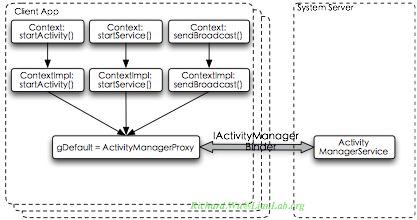特别声明:本系列文章LiAnLab.org著作权所有,转载请注明出处。作者系LiAnLab.org资深Android技术顾问吴赫老师。本系列文章交流与讨论:@宋宝华Barry
3.4 IActiivtyManager的Stub端实现
对于IActivityManager的Service的实现部分,因为整个Stub接口都已经在抽象类ActivityManagerNative里完成了,所以也跟aidl会有不一样之处,我们不需要创建一个Stub对象,然后再在这个Stub对象里提供具体的方法实现,而是只需要根据onTransact()解析出来的方法提供具体实现。一般的Remote Service,Stub对象是通过onBind()回调方法触发创建的,会返回一个IBinder的引用到客户端。对于IActivityManager来说没有这样的触发点,它反倒是会远程调用到这一回调方法,所以这里并不需要实现这部分代码,而是保持循环,提供这种onBind()触发能力。
IActivityManager的Stub端,是会运行在SystemServer进程空间里,由frameworks/base/services/java/com/android/server/am/ActivityManagerService.java实现的。从前面的代码可以看出,其实ActivityManagerNative类已经将Binder接收端的代码封装好了,此时,我们所需要的,只是写一个ActivityManagerNative的实现类(因为ActivityManagerNative是一个抽象类)。
我们可以再来看看ActivityManagerService.java的实现:
public finalclass ActivityManagerServiceextends ActivityManagerNative
implements Watchdog.Monitor, BatteryStatsImpl.BatteryCallback { 1
...
final Handler mHandler= newHandler() { 2
...
public void handleMessage(Message msg) {
switch (msg.what) {
case SHOW_ERROR_MSG: {
HashMap data = (HashMap)msg.obj;
synchronized(ActivityManagerService.this) {
ProcessRecord proc =(ProcessRecord)data.get("app");
if (proc != null &&proc.crashDialog != null) {
Slog.e(TAG, "App already has crash dialog: " + proc);
return;
}
AppErrorResult res =(AppErrorResult) data.get("result");
if (mShowDialogs &&!mSleeping && !mShuttingDown) {
Dialog d = newAppErrorDialog(mContext, res, proc);
d.show();
proc.crashDialog = d;
} else {
res.set(0);
}
}
ensureBootCompleted();
} break;
...
}
};
@Override
public boolean onTransact(int code, Parcel data,Parcel reply,int flags) 3
throws RemoteException {
if(code == SYSPROPS_TRANSACTION) {
...
}
try {
return super.onTransact(code, data, reply, flags);
} catch (RuntimeException e) {
if(!(e instanceof SecurityException)) {
Slog.e(TAG, "Activity Manager Crash", e);
}
throw e;
}
}
static classPermissionControllerextends IPermissionController.Stub { 4
ActivityManagerService mActivityManagerService;
PermissionController(ActivityManagerService activityManagerService) {
mActivityManagerService =activityManagerService;
}
public boolean checkPermission(String permission,int pid,int uid) {
return mActivityManagerService.checkPermission(permission, pid,
uid) == PackageManager.PERMISSION_GRANTED;
}
}
private class ServiceRestarterimplements Runnable { 5
private ServiceRecord mService;
void setService(ServiceRecord service) {
mService = service;
}
public void run() {
synchronized(ActivityManagerService.this) {
performServiceRestartLocked(mService);
}
}
}
public finalint startActivity(IApplicationThread caller, 6
Intent intent, String resolvedType, IBinder resultTo,
String resultWho, int requestCode,int startFlags,
StringprofileFile, ParcelFileDescriptor profileFd, Bundle options) {
enforceNotIsolatedCaller("startActivity");
int userId = 0;
if(intent.getCategories() != null && intent.getCategories().contains(Intent.CATEGORY_HOME)) {
userId = mCurrentUserId;
} else {
if(Binder.getCallingUid() < Process.FIRST_APPLICATION_UID) {
userId = 0;
} else {
userId =Binder.getOrigCallingUser();
}
}
return mMainStack.startActivityMayWait(caller, -1, intent, resolvedType,
resultTo, resultWho, requestCode, startFlags, profileFile, profileFd,
null, null, options, userId);
}
public intbindService(IApplicationThread caller, IBinder token, 7
Intent service, String resolvedType,
IServiceConnection connection, int flags,int userId) {
enforceNotIsolatedCaller("bindService");
if(service != null && service.hasFileDescriptors() == true) {
throw new IllegalArgumentException("Filedescriptors passed in Intent");
}
checkValidCaller(Binder.getCallingUid(), userId);
synchronized(this) {
final ProcessRecord callerApp = getRecordForAppLocked(caller);
if(callerApp == null) {
throw new SecurityException(
"Unable to find app for caller " + caller
+ " (pid=" +Binder.getCallingPid()
+ ") when binding service " + service);
}
ActivityRecord activity = null;
if(token != null) {
activity =mMainStack.isInStackLocked(token);
if (activity == null) {
Slog.w(TAG, "Binding with unknown activity: " + token);
return 0;
}
}
int clientLabel = 0;
PendingIntent clientIntent = null;
if(callerApp.info.uid == Process.SYSTEM_UID) {
try {
clientIntent =(PendingIntent)service.getParcelableExtra(
Intent.EXTRA_CLIENT_INTENT);
} catch (RuntimeException e) {
}
if (clientIntent != null) {
clientLabel =service.getIntExtra(Intent.EXTRA_CLIENT_LABEL,0);
if (clientLabel != 0) {
service =service.cloneFilter();
}
}
}
ServiceLookupResult res =
retrieveServiceLocked(service,resolvedType,
Binder.getCallingPid(),Binder.getCallingUid(), userId);
if(res == null) {
return 0;
}
if(res.record == null) {
return -1;
}
if(isSingleton(res.record.processName, res.record.appInfo)) {
userId = 0;
res =retrieveServiceLocked(service, resolvedType, Binder.getCallingPid(),
Binder.getCallingUid(),0);
}
ServiceRecord s = res.record;
final long origId = Binder.clearCallingIdentity();
if(unscheduleServiceRestartLocked(s)) {
if (DEBUG_SERVICE) Slog.v(TAG,"BIND SERVICE WHILE RESTART PENDING:"
+ s);
}
AppBindRecord b = s.retrieveAppBindingLocked(service, callerApp);
ConnectionRecord c = new ConnectionRecord(b, activity,
connection, flags,clientLabel, clientIntent);
IBinder binder = connection.asBinder();
ArrayList<ConnectionRecord> clist = s.connections.get(binder);
if(clist == null) {
clist = new ArrayList<ConnectionRecord>();
s.connections.put(binder,clist);
}
clist.add(c);
b.connections.add(c);
if(activity != null) {
if (activity.connections ==null) {
activity.connections = newHashSet<ConnectionRecord>();
}
activity.connections.add(c);
}
b.client.connections.add(c);
if((c.flags&Context.BIND_ABOVE_CLIENT) !=0) {
b.client.hasAboveClient = true;
}
clist = mServiceConnections.get(binder);
if(clist == null) {
clist = newArrayList<ConnectionRecord>();
mServiceConnections.put(binder,clist);
}
clist.add(c);
if((flags&Context.BIND_AUTO_CREATE) !=0) {
s.lastActivity =SystemClock.uptimeMillis();
if (!bringUpServiceLocked(s,service.getFlags(),false)) {
return 0;
}
}
if(s.app != null) {
// This could have made the service more important.
updateOomAdjLocked(s.app);
}
if(DEBUG_SERVICE) Slog.v(TAG, "Bind" + s + "with " + b
+ ": received=" +b.intent.received
+ " apps=" +b.intent.apps.size()
+ " doRebind=" +b.intent.doRebind);
if(s.app != null && b.intent.received) {
try {
c.conn.connected(s.name,b.intent.binder);
} catch (Exception e) {
Slog.w(TAG, "Failure sending service " + s.shortName
+ " to connection " + c.conn.asBinder()
+ " (in " +c.binding.client.processName +")", e);
}
if (b.intent.apps.size() ==1 &&b.intent.doRebind) {
requestServiceBindingLocked(s, b.intent, true);
}
} else if (!b.intent.requested) {
requestServiceBindingLocked(s,b.intent, false);
}
Binder.restoreCallingIdentity(origId);
}
return 1;
}
public finalint broadcastIntent(IApplicationThreadcaller, 8
Intent intent, String resolvedType, IIntentReceiver resultTo,
int resultCode, String resultData, Bundle map,
String requiredPermission, boolean serialized,boolean sticky,int userId) {
enforceNotIsolatedCaller("broadcastIntent");
synchronized(this) {
intent = verifyBroadcastLocked(intent);
final ProcessRecord callerApp = getRecordForAppLocked(caller);
final int callingPid = Binder.getCallingPid();
final int callingUid = Binder.getCallingUid();
final long origId = Binder.clearCallingIdentity();
int res = broadcastIntentLocked(callerApp,
callerApp != null ?callerApp.info.packageName :null,
intent, resolvedType,resultTo,
resultCode, resultData,map, requiredPermission, serialized, sticky,
callingPid, callingUid,userId);
Binder.restoreCallingIdentity(origId);
return res;
}
}
private finalintcomputeOomAdjLocked(ProcessRecord app,int hiddenAdj,
ProcessRecord TOP_APP, boolean recursed,boolean doingAll) { 9
...
return app.curRawAdj;
}
final voidperformAppGcLocked(ProcessRecord app) { 10
try {
app.lastRequestedGc = SystemClock.uptimeMillis();
if(app.thread != null) {
if (app.reportLowMemory) {
app.reportLowMemory = false;
app.thread.scheduleLowMemory();
} else {
app.thread.processInBackground();
}
}
} catch (Exception e) {
// whatever.
}
}
}
1 ActivityManagerService最终会是一个实现ActivityManagerNative接口方法的类,ActivityManagerNative里带抽象标记的方法,都需要在ActivityManagerService里实现。虽然基本的Binder接收端处理也还是在ActivityManagerNative类里实现的,但由于直接使用ActivityManagerNative类的地方,并不能将这一抽象类实例化,于是在客户端实际上只能得到ActivityManagerProxy,而服务端则可以通过ActivityManagerService得到具体的IActivityManager接口的Service实例。这样的代码实现则使构建在Binder收发两端的代码逻辑都被统一起来,但同时也可以在运行时通过不同的实例化能力被拆分开。由于ActivityManager还需要提供其他部分的交互功能,于是不光是实现ActivityManagerNative抽象类,同时还会实现Watchdog.Monitor,和BatteryStatsImpl.BatteryCallback这两个接口对象。
2 Handler对象。在Android世界里,Handler对象是多线程处理上的一种异常灵活的机制,Handler会与创建它的线程,以及这一线程所附带的MessageQueue绑定。而拥有Handler对象的线程,则具备从MessageQueue中取出消息进行处理的能力,如果Message本身是一个Runnable对象,则可以在当前线程内执行某种操作。这样的机制应用程序的多线程编程时多用于后台线程回调到UI主线程里,但在Android系统里,也会大量使用这种机制,实现消息管理上的灵活处理。Handler通过postMessage()方法将Message插入MessageQueue,而通过handleMessage()将消息取出并处理,而在一个Handler对象的实现里,一般只需要实现handleMessage()方法。
3 覆盖onTransact()方法。如我们前面所述的IoC模式在设计上的妙用,于是我们每次继承某个基类时,我们都有可能通过覆盖方法+反向调用的方式实现对基类的原有方法的动态拓展。在Android系统里,这一技巧被反复使用,我们即可以在父类方法之后添加一些新的处理,也可以将新加的处理插到父类方法处理之前,唯一做不到的是在父类方法执行中插入新的处理。当然,基于Binder的收发处理上有其特殊性,在ActivityManagerService里拓展的onTransact()处理,并没有公布出来,客户端的transact()并不会分发这样的消息,于是我们也可以认为这一种类似于private限定的RPC,可以通过特殊路径来发送这样拓展出来的Message,供内部使用。
4 内部实现的IPermissionController的Stub对象。IPermissionController实际上只需要一个接口方法,checkPermission(),这一部分涉及安全的功能,最需要在Intent分发时便被处理,于是我们就在ActivityManagerService里实现。而系统其他部分,则可以统一通过对IPermissionController远程接口的访问,得到权限验证功能。
5 ServiceRestarter对象,则提供Service的“监护”功能,当某一个Service处于Bounded生命周期内,又因为出错退出,或是由于系统资源不够被回收时,ServiceRestarter对象则会将Service进行重启。
6 startActivity()。应用程序里一般会通过Context.startActivity()将Intent发送出来,但实际上会通过IActivityManager这一接口,将消息发送到ActivityManagerNative。在ActivityManagerNative的onTransact()方法里会再调用一个它自己并没有实现,而在继承它的ActivityManagerService里实现的startActivity(),也就是我们这里看到的这一方法,通过ActivityStack来找到合适的Activity来响应Intent消息的请求。
7 bindService ()。因为我们前面以RemoteService为例,于是我们这里看看bindService()的实现(Remote Service必须以BoundedService为其生存期)。与Activity不同,Service不需要栈式管理,但需要更严格的并发控制,于是可以看到在整个bindService()实现里,都使用了synchronized限制符用于线程并发同步。在整个Service引用的获取过程里,差不多都是检测当前环境里是否已经存在所需要的Service,如果没有,则尝试启动它。
8 broadcastIntent()。与bindService()类似,既然我们可以使用Intent来启动合适的Service,同理我们也可以使用Intent来驱动Broadcast Receiver。在广播消息发送时,会通过内部实现的broadcastIntentLocked()来进行互斥性的消息发送。而在broadcastIntentLocked()里,则会对系统发送的Intent进行一系列特殊的操作,然后针对 sticky方式发送的Intent进行专门的处理,最后便会调用PackageManager来取得系统里会接收这一Intent的Receiver,然后再将消息发送到这些进程的MessageQueue。
9 计算OOM_ADJ。在应用程序设计时,我们看到,Android应用程序世界里有一种永不退出的机制,而会在系统内存不够时通过一个OOM_ADJ参数来杀死合适的进程以回收内存,这里便会计算并选择合理的进程。在本质上说,进程本身会通过其是否是处于前台交互,是否与前台交互相关等来确定其优先级,但在执行过程中,还是需要根据其活跃程序来判断是否该杀死该进程,如果这一进程使用频度很高,则杀死该进程则过于浪费系统资源。于是在这一computeOomAdjLocked()方法里,会根据Activity等执行实体在调度上的时间信息来动态调整OOM的相关信息。
10 针对进程进行垃圾回收。与标准Java虚拟机不一样,Android的DalvikVM是以进程为单位来构建虚拟机执行环境的,于是系统里不再有一个统一的Java虚拟机环境,不能进行全局的垃圾回收。于是,在这个performAppGcLocked()方法里,会尝试针对某个进程回收内存。
ActivityManagerService.java实现的代码很长,而且并非独立工作,实际上它只是frameworks/base/services/java/com/android/server/am这个包的调用入口。因为IActivityManager这个接口类可以说是整个Android系统的“调度器”,涉及消息分发、进程管理。虽然这样的把这样大量功能揉合到一起的设计思路并不是很优雅,也不够低耦合,但从整个系统构建来看,这样的设计便很好地贯彻了简单高效的设计思路。从编程角度来看,事实上,ActivityManagerService类只不过是ActivityManagerNative接口的具体实现,并不难理解。从应用程序角度,它会直接通过进程内预置的ActivityManagerProxy对象(通过ContextImpl对象来找到)向IActivityManager的Binder接收端发命令,如果我们系统里任何一个进程或是线程创建一个ActivityManagerService对象,则所有基于IActivityManager接口进行RPC调用的地方,都将使用这一ActivityManagerService对象响应其执行请求。从前面对于Android的进程模型的分析我们也可以看到,完成这样功能的进程会是一个叫SystemServer的系统进程。于是,所有的分析得到的结果,便是如下这样的执行模型:

当系统里拥有一个ActivityManagerService的实例,则任何系统组成部分、或是应用程序,都可以使用bindService()取回合适的Binder,然后再通过这一Binder通信管道完成后续的通讯。在ActivityManagerService实例存在之后,我们后续的操作就可以都通过aidl的方式来进行了。这种使用bindService()的方式,我们在系统里偶尔用到,但并非最常用的一种。
为什么?因为这种方式很低效,每次调用前需要通过bindService()来驱动Service的有效bounded生命周期。这样的应用情境也存在,比如蓝牙、VPN等功能,系统只是偶尔要使用,使用时通过bindService()来初始化Service的上下文环境,不再用时便可以通过unbindService()取消对Service的引用,从而可以可以按需分配地使用系统提供的各种功能。但对于系统里的绝大部分功能来说,它的生存周期是一直存在的,在系统运行过程里,需要一直给不同执行部分提供其功能。这样的Service不需要生命周期的控制,在系统运行起来后就会一直在系统内存在,全局提供系统内功能的共享。这样的Service,我们一般可以称之为SystemService,它们不再使用bindService()来驱动,而直接通过一个叫ServiceManager的功能部件来实现。